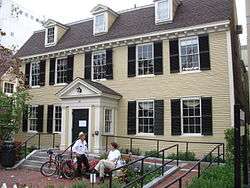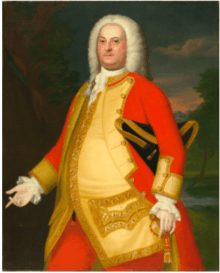William Brattle House
The William Brattle House is an historic house at 42 Brattle Street in Cambridge, Massachusetts. It is one of the seven Colonial mansions described by historian Samuel Atkins Eliot as making up Tory Row.[2] It remains in use by the Cambridge Center for Adult Education.
William Brattle House | |
 The William Brattle House in 2011 as the Cambridge Center for Adult Education | |
  | |
| Location | Cambridge, Massachusetts |
|---|---|
| Coordinates | 42°22′25.3″N 71°7′17.6″W |
| Built | 1727 |
| Architect | Unknown |
| Architectural style | Georgian |
| Part of | Harvard Square Historic District (ID86003654) |
| NRHP reference No. | 73000286 [1] |
| Significant dates | |
| Added to NRHP | May 8, 1973 |
| Designated CP | July 28, 1988 |
History

The house was built in 1727 for Major General William Brattle, at that time the wealthiest man in the Massachusetts Bay Colony, the son of William Brattle and nephew of Thomas Brattle. After the 1774 incident known as the Powder Alarm, an angry mob surrounded the Brattle mansion and forced the family to flee to Boston. At age 70, Brattle left Boston for Halifax, Nova Scotia on Evacuation Day, March 17, 1776, and died a few months later on October 26, 1776. He was buried in the Old Burying Ground (Halifax, Nova Scotia).[3][4]
According to Edward Abbott, writing in 1859,[5]
General Brattle conveyed all his real estate in Cambridge, December 13, 1774, to his only surviving son, Major Thomas Brattle... By the persevering efforts of Mrs. Katherine Wendell, the only surviving daughter of General Brattle, the estate was preserved from confiscation, and was recovered by Major Brattle after his return from Europe,—having been proscribed in 1778, and having subsequently exhibited satisfactory evidence of his friendship to his country and its political independence.
Nevertheless, the home was used temporarily as a headquarters by Thomas Mifflin and hosted a number of important figures from the early Revolutionary War period, including John Adams, who visited here before his trip to Philadelphia to sign the Declaration of Independence.[6]
For a time, the William Brattle House was home to American journalist Margaret Fuller. Fuller's uncle Abraham owned the home at the time, and the Fuller family moved in shortly after Timothy Fuller's unsuccessful campaign for lieutenant governor of Massachusetts as an Anti-Mason.[7] They arrived in September 1831 and left by April 1833.[8] The young Fuller did not enjoy her time here and referred to the opulent home as her "gilded cage". While living here on Christmas Day 1834, she ran out of a church service and had the inspirational thought "that there was no self; that selfishness was folly" and that she must teach herself to "act in cooperation with the constraints of life".[9]
The house was added to the National Register of Historic Places in 1973,[1] and included in an expansion of the Harvard Square Historic District in 1988.[10] It is currently owned and maintained by the Cambridge Center for Adult Education, a non-profit organization that was incorporated in 1938. CCAE also owns the historic Dexter Pratt House.
Gallery
.jpg) Brattle House in 1937
Brattle House in 1937
References
- "National Register Information System". National Register of Historic Places. National Park Service. April 15, 2008.
- Samuel Atkins Eliot (1913). A history of Cambridge, Massachusetts, 1630-1913. Cambridge Tribune. p. 75.
Tory Row.
- Find A Grave - William Brattle
- "William Brattle House". Cambridge Historical Society. Retrieved 2011-01-20.
He was the son of Thomas Brattle who founded Brattle Street Church in Boston, a prominent Congregational then Unitarian house of worship whose members included the Hancocks and the Adamses among other leading Boston families. Although in the 1770s, William Brattle was called a "fence-straddler" for simultaneously appeasing patriots while supporting the British. The Powder Alarm of 1774 revealed where his true allegiance lay.
- Edward Abbott (1879). Samuel Adams Drake (ed.). History of Middlesex County, Massachusetts: containing carefully prepared histories of every city and town in the county. Estes and Lauriat. pp. 305–358. ISBN 1-142-17517-0.
- Shand-Tucci, Douglas. Harvard University: An Architectural Tour. New York: Princeton Architectural Press, 2001: 72. ISBN 1-56898-280-1
- Von Mehren, Joan. The Minerva and the Muse: A Life of Margaret Fuller. Amherst, MA: University of Massachusetts Press, 1996: 48. ISBN 978-1-55849-015-4
- Capper, Charles. Margaret Fuller: An American Romantic Life: The Private Years. New York: Oxford University Press, 1992: 119–120. ISBN 0-19-509267-8
- Shand-Tucci, Douglas. Harvard University: An Architectural Tour. New York: Princeton Architectural Press, 2001: 72–73. ISBN 1-56898-280-1
- "MACRIS inventory record for William Brattle House". Commonwealth of Massachusetts. Retrieved 2014-03-07.
External links
![]()
- Brattle House listing at the Cambridge Historical Society
